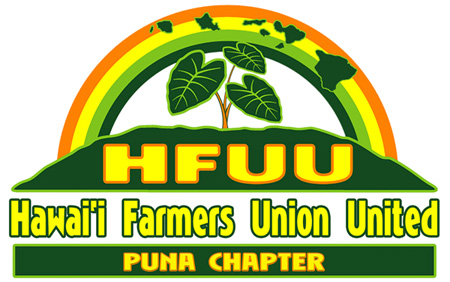Hawai’i-Puna Chapter

Chapter Notes: The Puna Chapter is on Hawai'i Island.
Meeting Schedule: TBD
Meeting Location: TBD
Puna Farmers and Land Description
According to the 2012 Hawaii State Agricultural Baseline Study, Puna supports the tropical fruit tree market in the retailing of fruit trees to individual landowners who plant small stands of fruit trees for home and neighborhood use. This decentralized form of farming rarely shows up on any tally of food production and is a growing segment of the Island’s local food supply. Small farmers on W.H. Shipman lands, in the Volcano area, and scattered elsewhere throughout the district, produce dry land taro, potatoes, pineapples, tomatoes, strawberries, and an assortment of vegetables that are primarily sold to the local market through retailers and farmers markets. There is also a growing amount of small backyard gardening and subsistence agriculture done in the vast agricultural subdivisions where residents have ample land to contribute to their own food self-sufficiency.
A private venture is growing jatropha on 300 acres near Kea‘au. The jatropha bean is high in oil content and can be processed into a biofuel. If yields are sufficient and harvesting practices can be perfected, this new crop could be expanded to aid in the State’s drive towards energy self-sufficiency. There are also several aqua cultural ventures in the district, including one that produces oyster fry for export to commercial producers around the country.
Farms in Upper Puna, from Mountain View to Volcano are scattered broadly. There is a cluster of small farms at the back of Wright Road in Volcano Village that has a long history of truck farm and flower production. The number of active farms in the area has fallen in recent years but there are several small farms producing red potatoes and other truck crops that are not grown elsewhere on the island. Proximity to the Kilauea Volcano and its volcanic emissions has had a negative impact on some crops in recent years but there is significant potential in this upper elevation micro-climate to produce food varieties that don’t grow well elsewhere.
Underlying most of Puna’s agriculture is a land settlement pattern that was shaped by the subdivision of both public and private lands into some 40,000 parcels from ½ to 50 acres in size. Although this rather unplanned parcelization presents challenges for modern land use and infrastructure development in the region, it also offers a rich opportunity for small landowners to participate in farm activities and to flourish or fail without seriously impacting the vitality of the diversified production of the region as a whole.
The large, sub-standard subdivisions, including Hawaiian Paradise Park, Hawaiian Acres, Fern Forest and others, are of sufficient size to support small agricultural endeavors both for subsistence and small scale commercial farm activity. There is no way to be certain that all of the properties highlighted in this figure are currently making a meaningful contribution of the Island’s food self-sufficiency, although the potential for small-lot, decentralized agricultural productivity is apparent.
